The West Coast Region is located along the South-West Coast of South Africa within the Western Cape Province. It extends from Blaauwberg in the Cape Metropolitan Area in the south, to the provincial border in Namaqualand in the north.
The West Coast Region borders on the Winelands District in the south, the Breede River District in the east, and the Northern Cape Province in the north and east. On the west, the region borders on the Atlantic Ocean, with its cold Benguela Current, which plays in important role in the ecology of the region.
The West Coast National Park lies 120 km north of Cape Town in the Western Cape province of South Africa. It is 27500 hectares in size. It is bordered by the Atlantic Ocean on the west and the R27 coastal road, and runs from the town of East London in the south up to the Langebaan lagoon. The park is particularly well known for its bird life and for the spring flowers which occur in the months from August to October, especially in the Postberg flower reserve section of the park.
Wildlife in the park includes large antelope such as eland and hartebeest, ostriches in the Postberg section, a flamingo population in the salt marshes of the Langebaan lagoon, African penguins, and many species of sea birds.
BLAAUWBERG STRAND (For Blaauwberg Accommodation go to Blaauberg Accommodation )
Bloubergstrand is a suburb of Cape Town located on the shores of Table Bay, about 25km to the north of the city centre.
Its name in Afrikaans means "blue mountain beach" after Blouberg, a hill not far inland from the coast.
It is mainly residential and attracts large numbers of visitors, both from the city, from other parts of South Africa and from overseas. Bloubergstrand is known for its white sandy beaches and the location from which the classic view of Table Mountain is seen. The decisive Battle of Blaauwberg took place near here in 1806. The British defeated the defending Dutch forces and occupied the Cape Colony.

DARLING (For Darling Accommodation go to Darling Accommodation )
Darling is a small town in a farming area on the west coast region of the Western Cape, about 75km from Cape Town. By the beginning of the 18th century about 29 farmers lived in an area called Groenkloof and on one of these farms, Langfonte, Darling was founded in 1853.
It was named after Sir Charles Henry Darling who came in 1851 to the Cape as Lieutenant Governor. The Darling Museum shows the history of the town and the Darling creamery which was established in 1899 by two Swedish settlers, Nils Georg Moller and G. Threnstrom, and was closed in 1950. Darling is famous for its wildflowers and since 1917 the annual Darling Wildflower show is held by the Darling Wildflower Society, founded in 1915 by Mrs. Suzanne Malan and Mr. Frederick Duckitt of Waylands.
The South African satirist Pieter-Dirk Uys performs many of his shows as Evita Bezuidenhout at Evita se Perron, a cabaret venue and restaurant in Darling. The adjacent arts and crafts market has been taken over in 2006 by the Darling Trust, a charitable organisation which addresses the problems of impoverished communities in the area through the establishment of grassroots projects. The first private school to open its doors in the Swartland area, Darling College, is also situated close to the entrance of the down on the Malmesbury side.
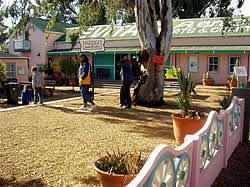
YZERFONTEIN ( For Yzerfontein Accommodation go to Yzerfontein Accommodation )
Yzerfontein is a small harbour town with about 1200 inhabitants on the west coast of South Africa about 90 km north of Cape Town. The main sources of income are tourism (especially during the wild flower season from August to October), and fishing. The West Coast National Park borders the town to the north, and Dassen Island is about 10 km offshore to the west.
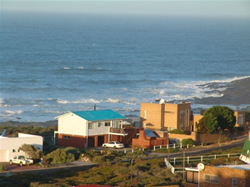
LANGEBAAN ( For Langebaan AccommodationN go to Langebaan Accommodation )
Langebaan is an idyllic little seaside town located at the edge of the Langebaan lagoon, just over 120kms North of Cape Town ... startling blue sea, spring flowers and fish braai’s.
Founded in 1922, this historical town was once a whaling station but has now been transformed into one of the busiest holiday destinations on the Cape West Coast.
Both nature-lovers and water sport enthusiasts flock to Langebann during the holiday season and it remains a major tourist attraction. The lagoon is part of a protected area, the West Coast National Park, and is also excellent for all kinds of water sport.Langebaan is world-renowned birding spot with migratory birds from as far as Russia stopping here annually.The Park is also a favourite destination with nature lovers and adventure seekers alike. During the flower season (July – September) the landscape is transformed into a giant garden as the area explodes iwith vibrant wild flowers in bloom. During winter and early spring one might catch sight of a Southern Right Whale in the lagoon where they return to calve each year.
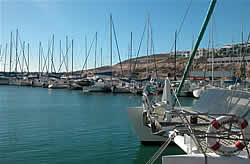
Paternoster ( For Paternoster Accommodation go to Paternoster Accommodation )
Paternoster (Our father) is a small fishing village on the western coast of the Western Cape Province of South Africa sitting alongside Paternoster Bay. The name comes from a type of fishing tackle, or, according to the home page of a local group, the name of a Dutch merchant vessel that was wrecked in the bay "three centuries ago".
The village has an off-the-beaten-track feel to it, with great nature reserves and generally unspoilt marine ecosystems and sea life. Because Paternoster is a small fishing community, fresh fish is always on the menu and it is a must-see place for the day traveller around Cape Town.
The coastline is in part sandy and in part rocky and inland from the village the countryside is quite arid. There is a relatively large public beach on Paternoster Bay, complete with a unique natural rock jetty. While the water is very cold most of the year, there is plenty of sun and a large expanse of sand where locals and tourists alike can catch some rays. Dolphins and whales can be seen from the beach or the surrounding hills. The village provides nice side trip for anyone visiting Cape Point or the nearby game reserves.
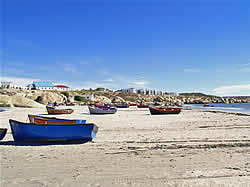
SALDANHA ( For Saldanha Accommodation go to Saldanha Accommodation
Saldanha Bay is a natural harbour on the south-western coast of South Africa, north west of Cape Town.
The town that developed around the bay, also called Saldanha, was incorporated with five other towns into the Saldanha Bay Local Municipality in 2000.
Saldanha Bay's location makes it a paradise for the watersport enthusiast, and its local economy being strongly dependent on fishing, mussels, seafood processing, the steel industry and the harbour. Furthermore its sheltered harbour plays an important part in the Sishen-Saldanha iron-ore project at which Saldanha Steel takes center stage.
With strong historic military links Saldanha is also host to a Naval training base and the South African Military Academy.
The SAS Saldanha Nature Reserve offers a display of wildflowers during late winter and spring while Southern Right Whales also visit the waters in and around the nature reserve.
The area has a Mediterranean climate but the annual rainfall is quite low; it verges on the desert region of Namaqualand.
Saldanha Bay is named after António de Saldanha, captain of a vessel in Albuquerque's fleet which visited South Africa in 1503. The name was first given to Table Bay, where Saldanha's ship cast anchor. On Table Bay being given its present name in 1601, the older appellation was transferred to the bay now called after Saldanha. In 1781 a British squadron under Commodore George Johnstone seized six Dutch East Indiamen, which, fearing an attack on Cape Town, had taken refuge in Saldanha Bay. This was the only achievement, so far as South Africa was concerned, of the expedition despatched to seize Cape Town during the war of 1781-1783. The port developed into a modern harbour only recently, when it became necessary to facilitate the export of iron ore from the Northern Cape. This required the construction of a railway more than 800km to the mines at Sishen in the Northern Cape and the construction of a deepwater jetty in Saldanha Bay to accommodate the Capesize ore carriers.
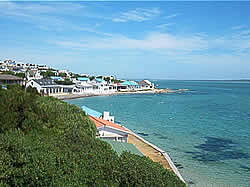 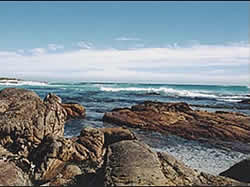
WEST COAST NATIONAL PARK
Just inland from the secluded harbour of Saldanha Bay one finds the azure waters of the Langebaan Lagoon, focal point of the West Coast National Park. Thousands of seabirds roost on sheltered islands, pristine golden beaches stretch endlessly into the early morning mist and brooding salt marshes are home to vast concentrations of migrant waders from the northern hemisphere. During the spring the strandveld is embroidered with a tapestry of multi-hued flowers, while in the Postberg section many antelope are to be seen in a setting that is as unique as it is idyllic.
The entrance to the park is some 100 km north of Cape Town, off the R27 highway. Most internal routes are tarred. The last section of the road to Postberg is, however, gravelled.
Activities
-
The park has been divided into 3 recreational zones:
- Zone A: multi-functional section for most water sports.
- Zone B: reserved for sailboats and board sailing (no power boats or angling).
- Zone C: wilderness area, which is closed to the public.
-
The Strandveld Educational Trail starts and ends at Geelbek Homestead.
-
The Postberg Flower Trail is open during the spring flowering season only.
-
Game viewing from own vehicle in the Postberg Section (only during the spring flowering season).
-
Picnic, barbecue and ablution facilities for day visitors in the Postberg Section (only during the spring flowering season).
-
Tea garden and light meals at the Geelbek Homestead.
-
Bird hides near the Geelbek Homestead.
-
Guided paddling trips and kayak hire by arrangement
Cape West Coast Accommodation, Cape West Coast Businesses, Cape West Coast History, Cape West Coast Information, Cape West Coast Facts, Cape West Coast Hisptorical Facts and Information, Information on Blaauwberg Strand, Darling, East London, Langebaan, Saldanah Bay, Paternoster, Yzerfontein, West Coast National Park |

